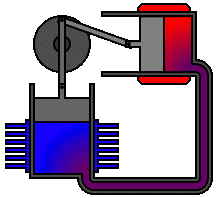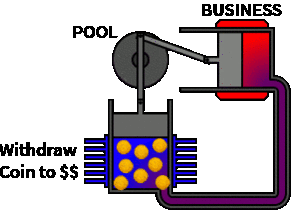
In part 1 we discussed, the impetus, motivations and goals behind VIVA and our plan to provide a permanent living wage to anyone that wants one.
In part 2 we gave an overview of each of the components, and basic explanation of how each component works.
If you haven't read parts 1 and 2 of this series, please go read them now or none of this is going to make a lick of sense.
This is where we discuss how each component plays a vital role in the VIVA economic engine,

To recap the most important parts...
Crown holders literally determine the supply of new viva entering the ecosystem.
They do this by voting for marketcap and price. These are target values that crown holders want to see the coin at over the course of the next 7 days.In order to mint new coins, you must stake, but you can never stake your own coins.
A mint borrows coins from the liquidity pool in order to stake. They pay an interest rate up front for this privilege. This interest rate can be whatever number the liquidity pool believes is necessary in order to grow or shrink the supply.
Coin supply is always in flux, the liquidity pool's job is to control supply by sinking or destroying them. Thus it is possible for a mint to mint a negative number of coins and this reduces the near term future supply. The liquidity pool can also simply destroy coins it has on the books, reducing total supply further.
These elements combine to prevent the price from falling too far while still allowing it to trade within a range, but we also want to prevent it from rising too fast. It's all about price stability.
Each Treasury Right has direct control of a certain percentage of the economy, but a significant amount of the economic output gains are vested directly in the pool.
Thus the subjective proof of work algorithm employed by the liquidity pool, involves 2 core components. The awards committee and the user vote.
The awards committee...

image courtesy of @klye
Has a job description that literally reads "My job is to hand over wheelbarrows full of cash to someone every day."
They are autonomous, but they are elected by the other members once a year during an annual meetup.
There is one committee member per crown and the initial committee member for a crown is the crown holder.
Committee Member is a salaried position, and this salary is set by the crown they represent.
The awards committee can set up its own rules and considering there are eventually going to be 42,000 of these people, as the system grows it is natural that they will have their own internal interest groups form. This sort of thing happens naturally, just look at curation groups on steemit such as curie, positivity, and whatever @sykochica, @ghostwriter, @badassbarbie, @alechahn, or @serioustruth are up to lately etc.
Perhaps the most important function of the pool is related to our user driven subjective proof of work system which is the closest thing we have to steemit's current upvote system.
Why is this so important?
. It keeps people engaged daily in the ecosystem.
. When they are engaged, they are involved, concerned and thinking about things.
. Engagement is how things improve and get better.
The thing to understand about our subjective proof of work is that it isn't there to compete with steemit, it's meant to compliment it. There will be a browser plugin that can detect if you're about to upvote someone on steemit who has a VIVA account and you can upvote them in both places at once.
The primary difference between VIVA's spow and steemit's spow is that with VIVA all upvotes are worth $1 no matter who you are or how much stake you have. The only thing stake gets you is the opportunity to upvote more often. There aren't any limits to the number of times you can upvote something, except your total daily upvote allocation. If you have 100 votes available and decide that something was worth all of them, then go for it. If you don't use your entire upvote allocation they do expire out. To qualify for a daily dividend you must upvote at least 7 different accounts each week.
OMG I think I see a Sybil attack! What's to prevent someone from just upvoting sock puppet accounts each day?
You need to have earned stake for your vote to mean anything. You can't just sign up a million bot accounts, you need a Crown holder to invite you. A crown holder doesn't need to vote for themselves or a sock puppet because they can literally just mint the money they need directly and have it now. Finally, due to compounding effects there is much more to be gained by just voting yourself. They're your votes, if you think you're more worthy or more in need than other people, then do what you want, that's why it's called Subjective.
By default, the money from upvotes goes into your pool account and increases your stake, although the pool may pay that straight to your regular wallet if there is a need to increase liquidity that day.
Whatever else you may be doing, you'll get a dividend payment every day for life so long as you participate in the Subjective Proof of Work, i.e. upvote at least one person every day.
Yes you're being hired to give money away to friends, family and even people you haven't met yet. But this has a specific purpose. It acts like a heart, pumping blood through the body of our economy which we treat like a living being. This is the push effect, but there also must be a "pull".
So how do I get cash in my wallet?
Eventually you will want to cease compounding and start drawing down. When your account is in drawdown mode, your dividend payment goes directly to your wallet. This is money you can spend each day.

image courtesy of @klye
The liquidity pool is attached to a bidirectional fiat gateway. This is how money exits the system and if your business decides to use the liquidity pool's payment processor you can also accept visa, mastercard, amex and even paypal so it's also one way money enters the system.
You can send viva internally to make payments for goods and services and as the ecosystem grows, this is something you will want to do. But in the meantime, Ledger Sciences (the developers behind VIVA) have agreements in place with ATM operators.

It's important to understand that Ledger Science's job description literally reads, do everything possible to encourage VIVA acceptance.
In addition to the ATM network, the VIVA network also has a debit card issuer on board, so VIVA as vX can be spent directly in stores.
When you spend this money outside the ecosystem, unlike other currencies, it doesn't cause a dump of currency on the open market, it is just added back to the books of the liquidity pool.
The pool is both a source and a sink of liquidity, but so is every other business activity attached to our engine.
vX is the other primary liquidity sink.
Where does vX come from?
Every time vX is minted, an amount of viva equivalent to the current market price of the vX instrument is destroyed.
vX gains simple daily interest but only compounds quarterly.
This rate is set by the pool and yes it is possible for it to be zero.
The variable interest rate is what makes vX such a powerful liquidity sink, people will buy it when the interest is high or as a hedge against viva volatility. Either way, whenever a vX is created, an equal amount of viva is destroyed and vice versa.
vX can never leave your wallet. But it is transferable and spendable.
When you spend vX you're really sending the vX back to the mint that created it. They destroy your vX, then mint an amount of viva equivalent to the current market price plus accumulated interest. The new viva is sent further on to it's destination and the interest is sent to your liquidity pool account.
Every 90 days, something similar happens, except it's automatic and the interest is autoconverted to vX.
This allows the blockchain to be aggressively pruned.
In order to limit abusive swap spam and to encourage holding, vX is subject to a 1% activity fee on transfers and swaps,. This is not true of the 90 day compounding cycle, or viva in general, but is true for swaps and transfers of vX.
This fee goes to the mint.
We've discussed sinks, and mentioned that all new viva is generated by the process of minting. Minting is the only source of new viva. Standalone minting of viva is not a valid business activity, there must be some business purpose to any minting activity.
But why?
It's because enterprise and entrepreneurship are the spark of life in every economy.
Businesses take in raw materials, process the materials into products and then output those products in exchange for money.
Where most coins fail is they assume that by changing the money used by the business that this will in some way help the business. They believe that for some reason a business would want to keep something other than fiat on hand.
In fact dealing in any foreign currency including crypto, just adds one thing most businesses do not want...

more complexity.
How many businesses actually take bitcoin?
Almost none, the vast majority of bitcoin businesses take coinbase or bitpay.
Coinbase & Bitpay accept the coins on their behalf and give the business some amount of fiat in exchange.
Even this tiny little tentative toe dip into the world of crypto is fraught with the perils of complexity and a lot of businesses try it out then quit using it after a few months because it just makes their job harder. Trying to get a business to even look at an altcoin is nearly impossible. One major problem is that business needs to be able to rely on it's infrastructure and it must be stable because they have to invest heavily in adapting their workflows and processes around this infrastructure.
This is one reason why there are LTS cycles in the open source world. A business knows that if they use the LTS version of an open source product they are guaranteed a certain number of years before they are forced to upgrade. Even when the software is free, upgrading it never is.
There is time and effort involved at all stages of the business in order to utilize the product, from testing and installation, to regression testing with existing systems and of course training.
All software, especially cryptocurrencies will fail to gain wide adoption if they force upgrades too quickly. There should be a minimum of 2 years between major versions and there should be a support window of at least a year to 18 months between major releases and EOL.
Now you know why Santander has managed to onboard so many banks to ripple. Ripple is compelling for banks because they offer an extremely stable API without a lot of futzing around with some 2.0 noise. It also helps that Santander pretty much owns Ripple outright and swift has proven unreliable as of late.
In the VIVA world, businesses are owners of entire swaths of the economy and we want them to build and run their business on our infrastructure, not just accept our coin.
This means that developers are paid to maintain the code and develop features that are wanted / needed, but going from major versions is a minimum 5 year process.
4 years of support before they even need to hear the word "2.0", with 1 year to 18 months of development, testing, debugging and an additional 24 months to make the jump before a release reaches EOL.
At the API level, we never deprecate or change an API without really good reason and those API calls that are deprecated are phased out over the course of 2 major release cycles. This means each major release of VIVA is an LTS release.
From the perspective of VIVA it does mean we need to be very forward looking and try to envision what the future actually entails. But on the whole, the system is already flexible enough to allow just about any business that might consider running ontop of AWS, Azure or Digital Ocean infrastructure.
In the next and final section we look at some of the actual businesses that will be using VIVA at launch and how they plan to use it, along with an explanation of our milestones and timetables and of course we will discuss the ICO.
Learn more in part 4
@williambanks/introduction-to-viva-part-4-how-do-you-bootstrap-a-new-economy
